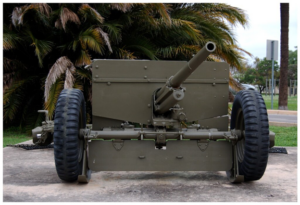U.S. M3 37mm Anti-Tank Gun
 In 2024, the Zephyrhills Military Museum of Military History added a full-size replica of the U.S. M3 37mm Anti-Tank Gun to its display. The M3 was the standard anti-tank gun for American infantry units at the beginning of WWII.
In 2024, the Zephyrhills Military Museum of Military History added a full-size replica of the U.S. M3 37mm Anti-Tank Gun to its display. The M3 was the standard anti-tank gun for American infantry units at the beginning of WWII.
Until 1940, the U.S. infantry used the low-pressure, low-velocity M1916 37mm Gun. The Spanish Civil War convinced Army planners that a more powerful anti-tank gun was needed.
The U.S. obtained two German Pak 36 37mm Anti-Tank guns to test and study. The Pak 36 entered production in 1936 and proved capable of penetrating the T-26 Russian tank. The Army Ordnance Corps used this information to design a lighter gun with similar ballistic qualities.
The U.S. built over 18,000 M3s between 1940 and 1943. The M3 could penetrate 1.5″ of steel armor. It was effective against German tanks until the Tiger and up-armored PzKfw III and IVs appeared in 1943.
The M3 was effective against Japanese Tanks throughout the war. Infantry soldiers liked the M3 because it was relatively light at 238 lbs. and could be towed by a jeep.
The high explosive cartridge M63 was effective against machine gun bunkers. The M3 was modified for use as a tank gun for the M5 Stuart light tank and the M3 Grant and Lee medium tanks. It was also mounted on the M8 Greyhound and M38 Wolfhound armored cars. A fully automatic version with a larger cartridge case and more velocity was used for anti-aircraft guns and was mounted in the nose of P-39 Airacobra and P-63 Kingcobra aircraft.
The Navy mounted the weapon on the LVT-(A)1 landing vehicle tracked and the Patrol Torpedo (PT) boat.
During the 1942 Battle for Guadalcanal, the Japanese were moving infantry reinforcements on barges. Our PT boats targeted these barges, however, the twin 50-cal M2 HB machine guns were not very effective at engaging them. PT crews began scavenging 37mm auto cannons from downed P-39 aircraft at Henderson Field. The crews fabricated mounts on the front deck of their boats and used crude sights to sink many barges.
One of the more famous 37mm users was LTJG John F. Kennedy, who had one mounted forward on PT 109 just before her last mission. Rumors were that he traded a bottle of scotch to an Army unit for an M3 37mm anti-tank gun.
He had the crew mount timbers to the front deck and strap the gun to the timbers. When the Japanese destroyer struck PT 109, the gun sank, but the timbers stayed afloat and allowed the crew to reach a nearby island.
For more information, see Charles C. Roberts, Jr.’s book The U.S. 37mm Gun in World War II.
If you are ever in the Tampa Bay area, please stop by the Zephyrhills Museum of Military History, 39444 South Ave, Zephyrhills, Florida. We are open every Saturday from 10 a.m. to 4 p.m. Admission and parking are free. Visit www.ZMMH.org or follow us on Facebook.
We also have a U.S. Cartridge 37mm HE M63 Practice Round on permanent display in the WWII Room.